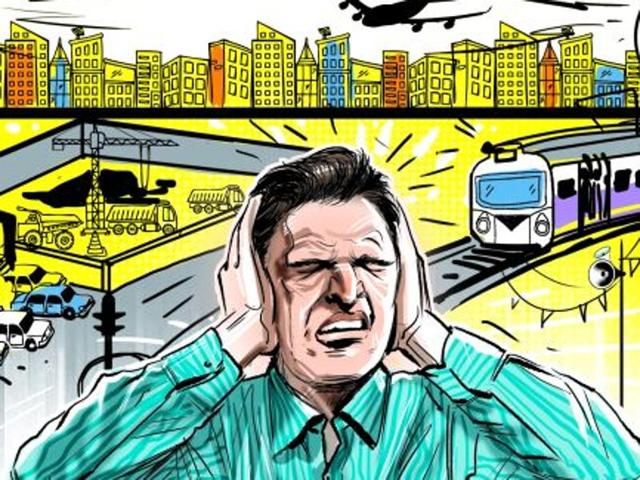Honking during peak hours on Mumbai roads a health hazard
A study by the Indian Institute of Technology – Bombay (IIT-B) found commuters are subjected to noise levels of more than 90 decibels (dB) daily because of honking.
Indiscriminate honking during a 25-km peak-hour journey from Bandra to Fort exposes Mumbaiites to the noise levels of a food processor kept on for around two hours continuously.

A study by the Indian Institute of Technology – Bombay (IIT-B) found commuters are subjected to noise levels of more than 90 decibels (dB) daily because of honking.
The study also found that those driving or travelling in motorised vehicles in Mumbai are exposed to more than 70dB – equivalent to the noise levels of a vacuum cleaner — for 50% of the commute time. And when a vehicle is stuck in a traffic jam, a commuter is exposed to an average noise level of more than 67dB — equivalent to a conversational speech – because of horns, engine noises and adjacent vehicles.
According to the law, recommended noise levels during the day for a vehicle are 75dB in industrial areas, 65dB in commercial areas, 55dB in residential areas and 50dB in silence zones
Studies have shown that in addition to hearing impairment, long-term exposure to traffic noise can impact a person’s sleep cycle, lead to high blood pressure, irregularity of heart rhythm, stress, irritability and reduce productivity.
“Commuting is a daily activity in Mumbai, higher than any other city in the country, as a result of which commuters are bound to be exposed to excessive noise during travel,” said Nagendra R Velaga, assistant professor, civil engineering department, IIT-B. “Drivers honk for a significant part of their trip owing to the lack of a proper traffic system, inadequate law enforcement and driver indiscipline, coupled with high traffic congestion.”
In the absence of data for in-vehicle noise pollution to commuters, the four-member IIT-B team developed a model to record the levels of in-vehicle traffic noise experienced by a passenger. Researchers said such an estimate will help policy makers introduce new modes of transportation.
Six routes in Mumbai were selected and noise data was collected inside buses, cars (with and without air-conditioning) and autos during day-time peak travel hours. Driving 112km, the team made 22 trips through different types of vehicles equipped with the GPS and noise-level meter. The study also took into account noise owing to interaction between road surface (bitumen and concrete) and tyres.
So passengers inside an auto and bus experience noise levels at 76.6dB and 78.0dB (alarm clock). While autos are more prone to higher noise levels owing to their comparatively open structure and low height, most public transport buses in the study were old with their engines making large amounts of noise during acceleration and gear change. Heavy traffic and honking during peak hours at road intersections exposes commuters to noise levels, exceeding 72dB. Similarly, average noise levels while travelling inside a non A/C car was 71.8 dB and in an A/C car was 65.6 dB.
“Mumbai has very narrow and congested roads with no control over decibel levels of horns. Unfortunately, the national and state laws on permissible limit of horns are not in sync,” said Sumaira Abdulali, convener, Awaaz Foundation.
Abdulali said while the state government passed a notification that the maximum permissible limit of horns should be 10dB above the engine and vehicular noise as specified by the Central Pollution Control Board, the Indian Bureau of Standards has much higher noise levels.
“These laws need to be in sync, and we need to know accurate noise levels. Along with a stricter enforcement mechanism, we need to bring down the decibel level.”
How it was done
A real-time noise level meter collected noise levels for second-by-second time intervals.
The meter was mounted on a tripod at a height corresponding to the ear-level of an average person’s height when sitting inside a vehicle to calculate accurate noise levels.
A hand-held Global Positioning System (GPS) instrument was carried throughout the experiments inside the test vehicle to obtain a spatial reference.
Both sound level meter and the GPS time were synchronized.
The same car was used for all ‘inside car’ data collection (both A/C and non A/C). Windows were kept open for non-air-conditioned car
Inside buses, authors traveled as passengers with the sound level meter instrument and GPS device.
Sound level meter was mounted on the rear seat of the auto. The same auto was used for all data collection.
Stay updated with all the Breaking News and Latest News from Mumbai. Click here for comprehensive coverage of top Cities including Bengaluru, Delhi, Hyderabad, and more across India along with Stay informed on the latest happenings in World News.
Stay updated with all the Breaking News and Latest News from Mumbai. Click here for comprehensive coverage of top Cities including Bengaluru, Delhi, Hyderabad, and more across India along with Stay informed on the latest happenings in World News.





